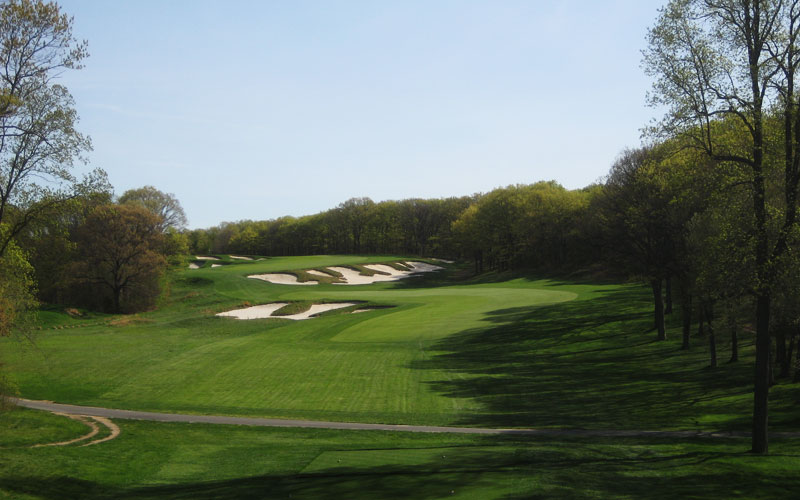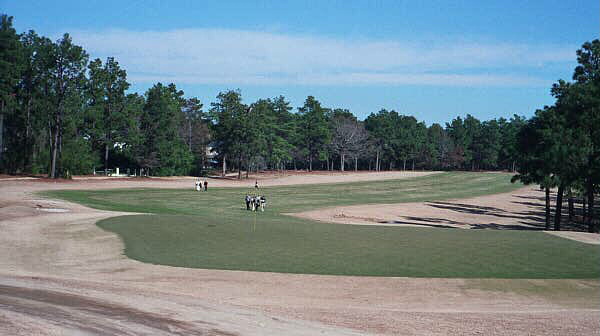I have been thinking about this one for about three months. Actually, more like 15 years but until recently I didn't have enough data points (holes seen) to make any connections.
What is the secret of building a hole that has "scale?" For a while I thought it was the obvious: make that sucker really long!
I have played my share of long holes, though, and never got a sense of "scale." Perhaps I should explain. Have you ever stepped on a tee and, for no understandable reason, had the thought pop into your head, "Now that's what a golf hole is supposed to look like!" Think about it, is there some kind of "ideal golf hole" imprinted deep in our brains, some model of perfection, that we subconsciously use to rate every hole we see -- and then a rarity comes along and releases the thought?
For me, it's a hole with "scale:" it has a grandeur or sweep and vista to it.
Here was the first time,
and for a long time the only time, I saw a hole and got that feeling; 530-yard par-5 4th, Bethpage (Black):

Years later, I stepped on a tee and for only the second time got that feeling. I couldn't find a photo from the tee, unfortunate because it would help you see what I'm getting at. 485-yard par-4(!) 5th, Pinehurst #2:

I thought on these for a long time. What was it about these two holes that triggered the reaction? Did they fit some deeply hidden template, or employ a golf design variant of the Golden Ratio; i.e., rose to "golf math" perfection?
Then a few months ago I played Rockport Country Club -- and found
two such holes! Considering that Coore was given an absolutely flat piece of ground (a clue to this secret of scale I think), surely the man deserves his station in the golf world.
Those holes are the 410-yard, par-4 2nd and the 540-yard, par-5 14th -- sorry for the absolutely horrible quality of the photos!
2nd hole, from the tee -- note amazing "convex" bunker right: it's like a "lump" of sand; how do architects do that? Green site, from approach
Green site, from approach Left side of green; compare size of swale to golfer: Coore used enormous "Maxwell Rolls" on the greens; also note random clump of earth in back bunker, just behind and to right of golf bag
Left side of green; compare size of swale to golfer: Coore used enormous "Maxwell Rolls" on the greens; also note random clump of earth in back bunker, just behind and to right of golf bag Right side of green
Right side of green 14th hole, from tee; again, apologies for poor pic quality -- flag is right of bunker / tree formation
14th hole, from tee; again, apologies for poor pic quality -- flag is right of bunker / tree formation View from landing area
View from landing area Approach -- note fairway washboard: lots of these out here, solely due to the hand of man
Approach -- note fairway washboard: lots of these out here, solely due to the hand of man Green; Coore set his fairways bucking and heaving then let those waves crash right through the greens
Green; Coore set his fairways bucking and heaving then let those waves crash right through the greens Another view
Another view Looking back on the hole from behind
Looking back on the hole from behind
I've got a few questions. When you look at these holes, are there any similarities you see that might produce this sense of "scale?" (Although two of them are par 5s, none of them would be considered really long by today's standards. Another clue I think: they look much longer than the card yardage; is this an essential element of "scale?")
Have you ever got this feeling on a tee? What holes and why? What was it about those holes? Did any or all of them have this slippery quality of "scale," at least how I've (poorly) defined it?
Now for the tough ones: If you set out to build a hole with "scale," what principles or rules of thumb might you follow? Is there some equivalent of the Golden Ratio? Would you know in advance you were creating one of these beauties, or is it down to inspiration and chance?
I have a few ideas but am not certain of them, thus the post.
Thanks,
Mark